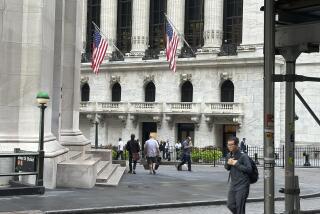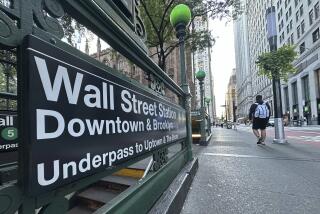Taking Stock of Wall Street : Markets: The crisis-inspired stock plunge matters, but stocks are an unreliable economic barometer. When they crashed in October, 1987, not much happened.
Fallout from the Persian Gulf crisis has drifted thousands of miles to Wall Street, where the summer’s rally has fizzled like a Roman candle.
As energy prices have soared, stock prices have plunged, capturing headlines, spooking investors and fanning fears of recession. Overall, the market has lost more than $324 billion in value since Iraqi troops rolled into Kuwait, according to Wilshire Associates in Santa Monica.
But for all the clamor, does the general public have reason to care?
“The stock market is just not that important--particularly in its day-to-day and week-to-week changes,” argues David I. Levine, a professor of economics at UC Berkeley’s Walter A. Haas School of Business.
Despite the attention lavished on Wall Street, its significance in the grand economic scheme remains unclear. Four out of five U.S. households own no stock or mutual funds, excluding pension plans, according to studies at the University of Michigan. Widespread forecasts that the crash of October, 1987, would trigger an economic slump proved wrong.
Yet it would be a mistake to dismiss today’s financial turmoil as unrelated to the rest of the nation, some analysts say. Unlike the 1987 crash, it reflects genuine economic problems that the public understands well: the damage that higher energy costs can wreak in the form of inflation and higher interest rates.
“We’re not as wealthy as we were, there’s no question about that,” said Frank C. Wykoff, an economics professor at Pomona College in Claremont. “(Iraqi President) Saddam Hussein has done that to us, whether he meant to or not.”
Economists pay attention to the stock market for a few reasons. Its changes often mirror the public mood, as jittery stock movements seem to be doing right now. A prolonged rise or fall may point the way to the future course of the U.S. economy. Moreover, the skittish market has important, albeit indirect, effects on the more plodding economy of industrial America.
“There is an economy of work and production, and there is an economy of financial transactions,” observed Robert L. Heilbroner, an economist at the New School of Social Research in New York. “They are certainly bound together, but they are certainly loosely bound together.”
Indeed, the market’s connection to things outside the financial world is tricky to measure. Its record as economic seer, for instance, is decidedly mixed.
Government officials consider the stock market important enough to include in their index of leading economic indicators, along with such weather vanes as building permits and orders for business equipment.
Yet after the October, 1987, market debacle, the U.S. economy continued to grow, with the help of lower interest rates engineered by the Federal Reserve Board. Similarly, a 190-point dive by the Dow Jones industrial index in October, 1989, amounted to a blip on an analyst’s computer screen, an economic non-event.
“You pick any recession you want and you’d find the stock market started to decline before it,” said Edward E. Yardeni, director of economics at Prudential-Bache Securities in New York. “But the stock market has also predicted a few we haven’t had.”
The market also is an unreliable barometer of spending in the economy.
Economists teach that declines in wealth translate to declines in spending, perhaps a cutback of a few cents for each $1 lost. Yet the link is not easy to establish after short-term market swings--even huge ones.
Consider the 1987 slide. Between August and late October, more than $1 trillion in “paper” wealth was erased, according to calculations by Wilshire Associates. But to pinpoint a spending decline that is caused by short-term market swings is like looking for “a needle in a haystack,” Wykoff said.
A whole range of factors, including real estate values and job skills--what economists call human capital--can affect a person’s sense of affluence and willingness to spend. A momentary jump in the stock market doesn’t set off a stampede of luxury purchases, and a temporary fall doesn’t create widespread panic.
For people to view stock market declines as more than ephemeral shifts on paper, “I think people have to really begin to believe that it’s a permanent downward adjustment,” said Dennis E. Logue, a financial economist at the Amos Tuck School of Business Administration at Dartmouth College in Hanover, N.H.
“If the stock market blips up or blips down around some normal, long-run rate of return, I’m not sure those blips matter very much.”
What may matter more is the way that weakness in the market can dampen the plans of business executives to spend and invest. When values are high, issuing new stock can be a painless way for companies to raise investment money. When values are low, by contrast, companies are forced to issue a larger number of shares to raise the desired amount of cash.
But executives may not want to issue too many shares, in part because that dilutes each shareholder’s ownership stake in the company, said Richard J. Sweeney, a professor of finance at Georgetown University.
As a result, rank-and-file workers may suffer because their wage prospects ultimately depend on investments that will boost their productivity. “If I’m a worker in that company, I’m not going to be getting more wages for being more productive,” said Sweeney. “That’s not attractive.”
The market also can affect some 43 million Americans who may own stock through their private pension plans. Barring a financial cataclysm, however, the effects are limited.
Most pensioners rely on a type of plan that provides a guaranteed benefit that is not linked to market swings. Despite the October, 1987, crash, most pension plans finished the year with more assets than they had at the beginning, according to the Employee Benefit Research Institute in Washington.
The same goes for retirees: Even most of those who took a hit in late 1987 finished the year better off than they were before the vast run-up earlier in the year, EBRI found.
For workers and pensioners, a potential downside of prolonged weakness in the stock market is that that their employer might be less likely to institute new, improved benefits, said Joseph S. Piacentini, a research associate at the institute.
“When the market is strong, it makes it cheaper to maintain a generous pension plan,” Piacentini said. “In the long run, with weaker markets you’d expect some downward pressure on benefits.”
Perhaps the least tangible way the stock market affects the overall economy is the role it plays in shaping Americans’ sense of financial security. The public mood is important: Consumer spending amounts to two-thirds of all spending in the economy and is tracked closely by analysts.
Forecasts that the 1987 crash would cause a recession assumed that nerve-wracked consumers would hold off on major purchases, dragging down the economy. In fact, auto sales fell after Black Monday, and there were other warning signs of a broad slowdown. But when the crash was not followed by ominous developments, such as a rise in unemployment, business picked up and the economy continued to grow.
Today’s worries are different, economists say, because they arise from potentially serious economic problems that have nothing to do with the spectacle on Wall Street. The current concerns also hit home in a way that the 1987 crash did not, because many adults retain distasteful memories of past oil shocks.
In 1987, “People said this is just some funny gyration in the stock market, and it doesn’t affect me,” observed F. Thomas Juster, a professor of economics at the University of Michigan. “But everybody understands the effect of oil prices on inflation. Now people say this is a real event.”
As a result, overall consumer confidence in August plunged to its lowest level in more than seven years, according to a survey by the Conference Board in New York. Expectations about job availability and business conditions are the gloomiest they have been in years.
But it would be wrong to cite the mercurial stock market as the main cause of such doubts, said Jason D. Bram, an economist with the business research organization. Job security, inflation and, to a lesser extent, interest rates and real estate values, all influence the public’s sense of well-being more than the stock market does, he said.
Thus some experts would rank the latest sparks in the financial world way down the list of what’s really important to America’s long-term prosperity. “If you’re worried about the future, you should be worried about infrastructure and schools--not the stock market and Iraq,” counsels Berkeley’s Levine.
THE VOLATILE STOCK MARKET The crash of Black Monday, 1987, was part of a much larger slide that began in late August and continued until late October. After a huge rally earlier in the year, the market peaked on Aug. 25. The crash took place on Oct. 19, but the market didn’t hit bottom until Oct. 26.
This summer’s rally came to an abrupt finale in mid-July, two weeks before the Persian Gulf crisis. The recent peak was on July 16. But the slide didn’t accelerate until Iraq invaded Kuwait at the beginning of August. Stocks hit their recent bottom on Aug. 23 and have recovered only partially.
The table below shows the Wilshire 5,000 index for these key periods. The index seeks to approximate the dollar value of all stocks traded in the United States.
THE CRASH OF 1987
PEROID DAILY CLOSE PERIOD DAILY CLOSE $DECLINE PERCENT BEGINNING (IN BILLIONS) ENDING (IN BILLIONS) (IN BILLIONS) DECLINE Aug. 25 $3,299.440 Oct. 19 $2,310.297 $989.143 29.98% Oct. 16 2,813.481 Oct. 19 2,310.297 503.184 17.89 Aug. 25 3,299.440 Oct. 26 2,225.102 1,074.338 32.56
THE CRISIS IN THE GULF, 1990
PEROID DAILY CLOSE PERIOD DAILY CLOSE $DECLINE PERCENT BEGINNING (IN BILLIONS) ENDING (IN BILLIONS) (IN BILLIONS) DECLINE July 16 $3,518.324 Aug. 23 $2,911.709 $606.615 17.24% Aug. 1 3,377.797 Aug. 23 2,911.709 466.088 13.80 Aug. 1 3,377.797 Aug. 31 3,053.601 324.196 9.60
Source: Wilshire Associates
More to Read
Inside the business of entertainment
The Wide Shot brings you news, analysis and insights on everything from streaming wars to production — and what it all means for the future.
You may occasionally receive promotional content from the Los Angeles Times.










